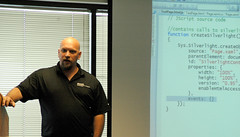eRubyCon wrapped up yesterday.
First talk of the morning – I heard Muness Alrubaie and Dan Manges, both from ThoughtWorks, talking about Ruby and Agile on a large project with ThoughtWorks. They have 30 people working on a single app – all at one war table in a conference room in Atlanta for 10 hours a day 4 days a week. They pair with the guy next to them. They shift pairs on every iteration. They move extremely quickly. It was interesting to hear them talking about the challenges of working an agile project with that many people. One of the small changes was that they had to formalize the format of their story cards, estimation and such. On smaller teams, they could be a touch looser because people all knew each other and each others styles. They standardized on the desktop setup, toolset that they are going to use, configuration of the tools such as colors in the editors and other things that are usually personalized per developer or at least on a pair level. The big thing that would have been fantastic to see would have been a ton more on the gotchas and pitfalls to watch out for. These are hard to verbalize but important. Some of these can be inferred from the things that they had to alter for the the larger group. They didn’t go into detail on issues that they had with integration which I’m sure that they had with that many pairs making extraordinarily aggressive changes a language that’s a compact as Ruby is. That has to lead to stomping on each other occasionally. It was a fantastic talk – I just always want more. One thing is for sure – they are proving that agile can work in large projects.
 Then I got to talk! This was a ton of fun. I’ll be honest, it was daunting to be speaking at eRubyCon and especially after so many fantastic speakers. My session was an introduction to Silverlight for Ruby programmers. My big demo was that I wrote a simple rails app that served up a Silverlight front end and then the Silverlight front end communicated back to the server via JSON. That was cool. I’ll be posting my slide deck here in a little bit. It’s not all my deck, I stole a lot of it from Scott Barnes and adapted it to work with my style and such. I did video the talk and plan on posting it at some point in the near future – but that’s going to take some work and time. I really wish that I had been able to show IronRuby off, but I don’t have any bits as they are supposed to drop next week. To quote John Lam, I had an “unfortunate timing issue” as the team is putting something out publicly next week.
Then I got to talk! This was a ton of fun. I’ll be honest, it was daunting to be speaking at eRubyCon and especially after so many fantastic speakers. My session was an introduction to Silverlight for Ruby programmers. My big demo was that I wrote a simple rails app that served up a Silverlight front end and then the Silverlight front end communicated back to the server via JSON. That was cool. I’ll be posting my slide deck here in a little bit. It’s not all my deck, I stole a lot of it from Scott Barnes and adapted it to work with my style and such. I did video the talk and plan on posting it at some point in the near future – but that’s going to take some work and time. I really wish that I had been able to show IronRuby off, but I don’t have any bits as they are supposed to drop next week. To quote John Lam, I had an “unfortunate timing issue” as the team is putting something out publicly next week.
After that I got to listen to Glenn Vanderburg with the closing keynote of the conference. He talked about a lot of the things that I’ve been talking (I need to blog a lot of this) about recently with IT as a cost center and how that’s dangerous. He had some great points about the implications of cost centers. In short, cost centers lead to wanting to cut down on the costs which leads to wanting to build things fast, cheaply and have them last for 30 years and are easy to update and change constantly to meet new requirements and regulations. He quoted Scott Bellware quite a bit and talked about the process of “Software Creationalism”. In short, Scott’s (and Glenn’s) contention is that the vast majority of tools and frameworks out today are all about the point of creation of software and don’t have nearly enough focus on the ongoing survivability and maintenance of the application. That results in “The creation of software is easy but the changing of software is hard”. I strongly agree that this is the current state of the discipline. Obviously, his conclusion is that what the enterprise needs is agile development. “To make it easier to change software, then built it by changing it”.
Another great quote – “If that’s not a one line change, then we need to refactor until it is.” – Glenn Vanderburg, eRubyCon 2007.
Software Creationalism – Scott Bellware [MVP]